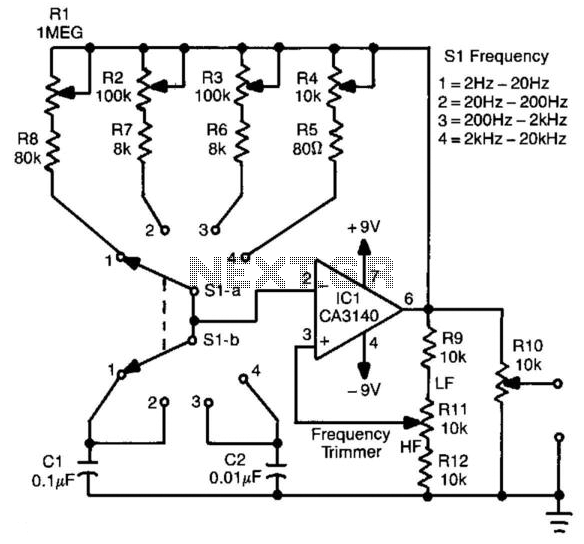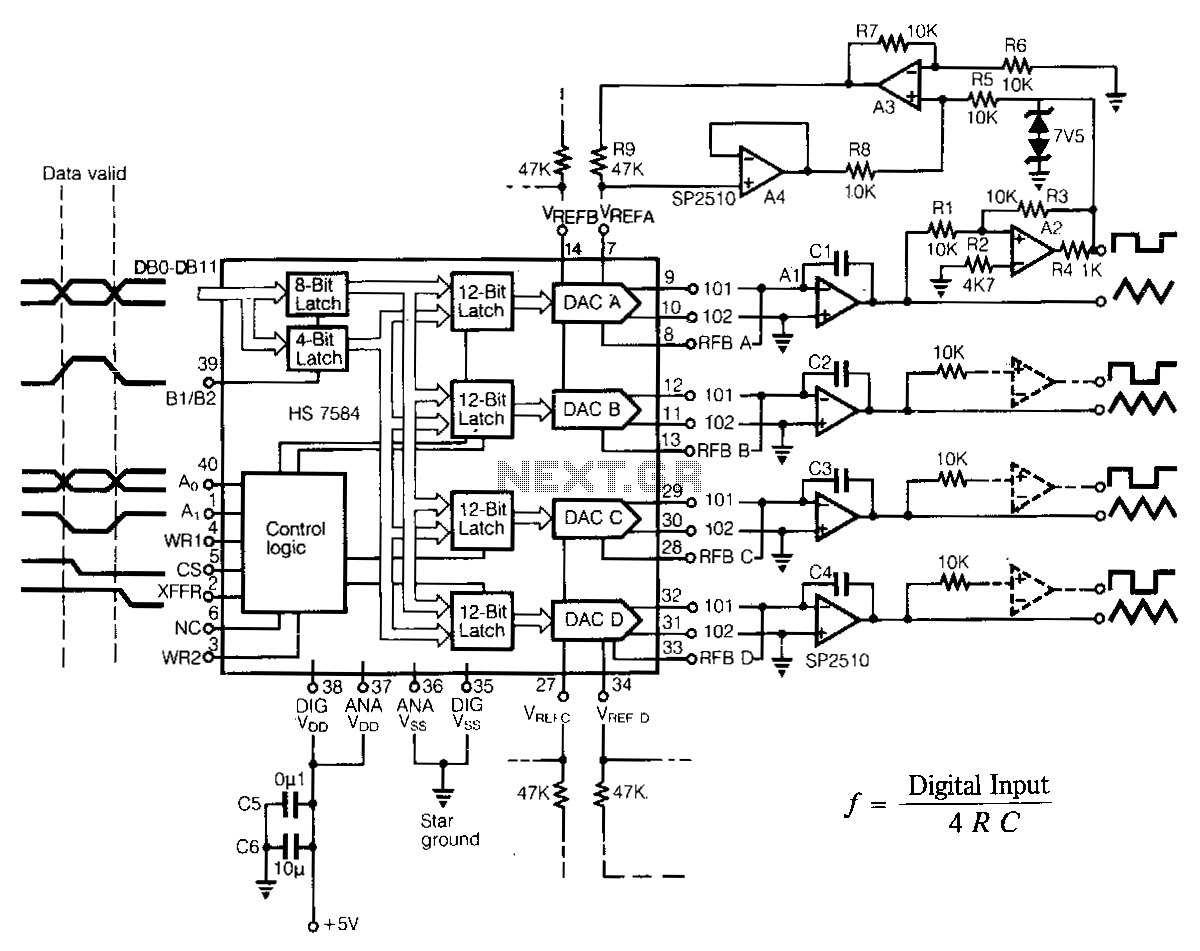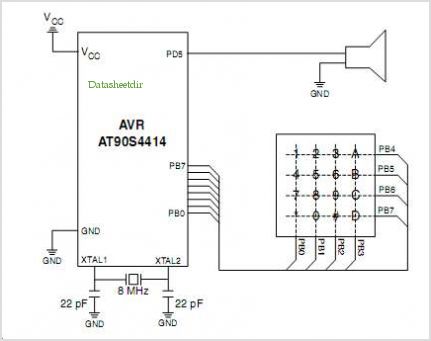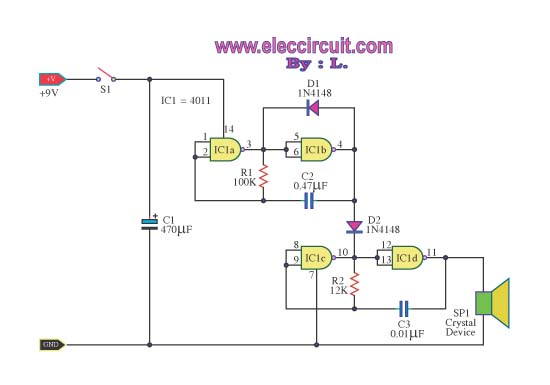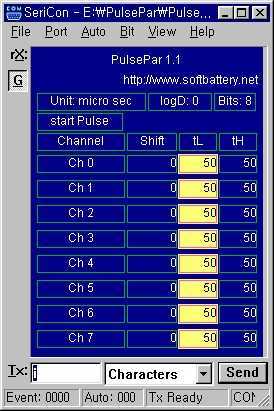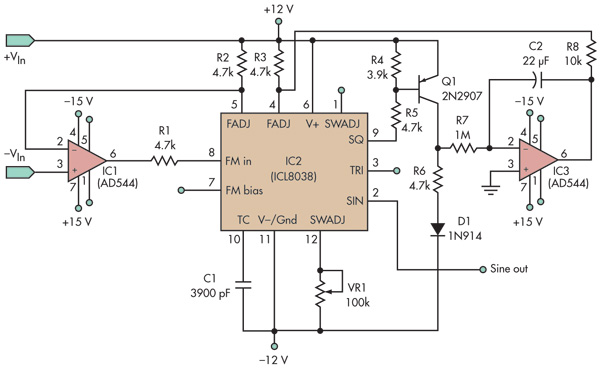
Oscillator-clock generator
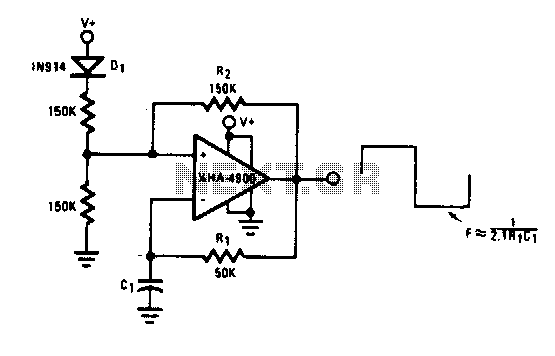
This self-starting fixed frequency oscillator circuit provides excellent frequency stability. R1 and C1 form the frequency-determining network, while R2 supplies regenerative feedback. Diode D1 improves stability by compensating for the difference between Voh and Vsupply. In applications requiring a precision clock generator up to 100 kHz, such as in automatic test equipment, C1 may be substituted with a crystal.
The self-starting fixed frequency oscillator circuit is designed to generate a consistent output frequency with high stability, making it suitable for various applications, particularly in systems that demand precise timing signals. The circuit incorporates a frequency-determining network composed of resistor R1 and capacitor C1. This network establishes the oscillator's fundamental frequency, which is critical for applications needing accuracy.
Regenerative feedback is provided by resistor R2, which plays a vital role in maintaining oscillation. The feedback mechanism ensures that the output signal reinforces the input, allowing the circuit to sustain oscillations over time. The selection of R2 is essential, as it influences the gain and stability of the oscillator.
Diode D1 is included in the design to enhance the circuit's stability. Its function is to compensate for variations between the output high voltage (Voh) and the supply voltage (Vsupply). By addressing these voltage discrepancies, D1 helps maintain a consistent output frequency, thereby improving overall performance.
For situations requiring a higher degree of precision, particularly in clock generation up to 100 kHz, capacitor C1 can be replaced with a crystal oscillator. This substitution significantly enhances frequency accuracy and stability, making it ideal for automatic test equipment and other applications where precise timing is crucial. The use of a crystal oscillator ensures that the circuit meets stringent timing requirements while maintaining the fundamental design principles of the original oscillator circuit.This self-starting fixed frequency oscillator circuit gives excellent frequency stability. Rl and Cl comprise the frequency determining network while R2 provides the regenerative feedback. Diode Dl enhances the stability by compensating for the difference between Voh and Vsuppiy In applications where a precision clock generator up to 100 kHz is required, such as in automatic test equipment, Cl may be replaced by a crystal. 🔗 External reference
The self-starting fixed frequency oscillator circuit is designed to generate a consistent output frequency with high stability, making it suitable for various applications, particularly in systems that demand precise timing signals. The circuit incorporates a frequency-determining network composed of resistor R1 and capacitor C1. This network establishes the oscillator's fundamental frequency, which is critical for applications needing accuracy.
Regenerative feedback is provided by resistor R2, which plays a vital role in maintaining oscillation. The feedback mechanism ensures that the output signal reinforces the input, allowing the circuit to sustain oscillations over time. The selection of R2 is essential, as it influences the gain and stability of the oscillator.
Diode D1 is included in the design to enhance the circuit's stability. Its function is to compensate for variations between the output high voltage (Voh) and the supply voltage (Vsupply). By addressing these voltage discrepancies, D1 helps maintain a consistent output frequency, thereby improving overall performance.
For situations requiring a higher degree of precision, particularly in clock generation up to 100 kHz, capacitor C1 can be replaced with a crystal oscillator. This substitution significantly enhances frequency accuracy and stability, making it ideal for automatic test equipment and other applications where precise timing is crucial. The use of a crystal oscillator ensures that the circuit meets stringent timing requirements while maintaining the fundamental design principles of the original oscillator circuit.This self-starting fixed frequency oscillator circuit gives excellent frequency stability. Rl and Cl comprise the frequency determining network while R2 provides the regenerative feedback. Diode Dl enhances the stability by compensating for the difference between Voh and Vsuppiy In applications where a precision clock generator up to 100 kHz is required, such as in automatic test equipment, Cl may be replaced by a crystal. 🔗 External reference
